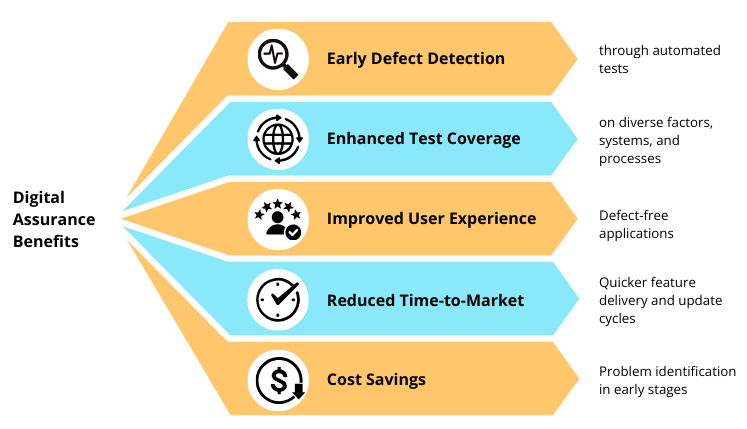The global impact of digital transformation on business processes has risen dramatically. Organizations operate with high agility, requiring them to deliver robust solutions within short timeframes.
Digital transformation involves using digital technologies such as AI (Artificial Intelligence), ML (Machine Learning), IoT (Internet of Things), Big Data, and Cloud Computing to make organizations more efficient and improve customer outcomes. However, these goals cannot be achieved unless there is regular digital assurance established in place.
The concept of quality assurance is present in one of the most essential phases of the SDLC since it is linked to the usability, image, and performance of software solutions that influence the company’s overall performance.
However, according to a Gartner report, 88% of service leaders believe their current quality assurance (QA) processes are ineffective.
Digital assurance is the method of structuring risk management, development, quality assurance (QA), and support for digital applications and services. The idea is to shape a satisfactory and efficient solution for the stakeholders.
Additionally, it encompasses the testing and validation efforts throughout the SDLC using sophisticated instruments and processes for early defect detection.
Moreover, it adds value to QA by emphasizing the customers’ perspective of the complete digital solution. This includes apps, networks, devices, and user experiences on an enterprise level.
Besides this, it uses automation, data, and especially the CI/CD pipelines to detect defects at an early stage. This allows for preemptive resolution of issues to avoid cost escalations.
Lastly, it is not just a type of testing. On the contrary, it tightens the approach, starting from a simple search for defects to the result of preventing them.

Quality Assurance has long been the backbone of product development. It primarily focuses on the processes and activities designed to ensure that the product meets specified requirements and standards. QA encompasses a range of practices, including:
Ensuring that the product functions as intended, identifying and fixing defects.
Continuously refining development processes to enhance product quality.
Adhering to industry standards and regulatory requirements.
QA is often a linear process, deeply integrated into the product development lifecycle. It has the primary focus of preventing defects and ensuring reliability through rigorous testing protocols.
As the digital transformation landscape matures, the concept of digital assurance and transparency have emerged rapidly. It covers more extensive and multifaceted requirements of contemporary digital environments.
Additionally, DA goes further than QA in addressing all aspects of the digital software life cycle, guaranteeing reliability, resistance to malicious attacks, and ensuring the highest levels of customer satisfaction.

Refers to all the digital-related components that include the application, devices, networks and platforms.
Engineering-oriented business processes that employ the use of automation, and the application of artificial intelligence in real-time analysis to offer quick feedback.
Tightly linked with the experience of users; it means that the interaction process with the digital products must be optimized.
Being able to determine where those gaps are pre-emptively and making certain that it is in line with the regulations.

Automated test cases facilitate regression testing, helping detect and correct defects in early stages.
All-round test coverage on diverse factors, systems, and processes, which eliminates the chances of having undiscovered flaws.
By offering applications that are free from defects, hence contributing to the benefit of users and the company’s brand image.
Defect reduction also reduces the time taken for the removal of impediments, improving feature delivery and update cycles.
Problem identification and resolution in early stages leads to reduced expenses in rework and post-release maintenance.
Digital assurance and transparency play a pivotal role in efficient defect reduction through the following strategies:
Using automation testing tools guarantees the standard and repeatability of testing results as well as decreases the influence of human factors.
Testing occurs in earlier stages to prevent flaws which might interfere in the later stages of SDLC.
Strengthening the CI/CD processes helps to develop more test cases to ensure higher coverage.
Analytics and AI-based testing methodologies lead to the identification of possible defects, test coverage, and high-risk zones to focus on.
The integration of development, QA and operations enhances the communication and coordination of issues.
Moving forward, the role of digital assurance and transparency with respect to the minimisation of defects will only intensify. Testing process will see higher levels of automation, where algorithms generate test cases, execute them and analyse results.
Moreover, continuous assurance has become a new norm, with companies integrating DevOps and continuous delivery into their processes. This change of focus will ensure proactive action based on changes in requirements to deliver value to the end customers.